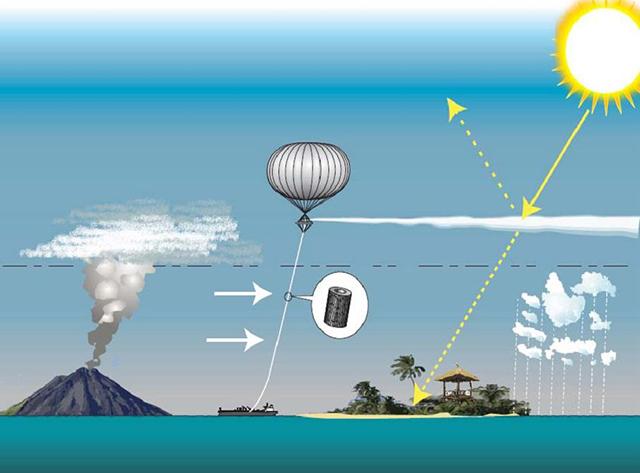
Manipulating climate to fight global warming

The amount of CO2 in the atmosphere continues to increase and a world agreement on climate seems far off. So why not use technology to change the climate artificially? swissinfo.ch asks some Swiss scientists about the pros and cons.
An enormous mirror in outer space to deflect the sun’s light and cool the earth, or a ship that cruises the oceans feeding the algae and reducing the CO2 in the atmosphere – just science fiction?
“Not at all”, says Nicolas Gruber, a professor of environmental physics at the Federal Institute of Technology (ETH) Zurich. “The idea of mirrors in space is doable, though it would cost a lot. Fertilising the oceans is an approach that has already been tried. It has turned out to be rather ineffective, though”, he told swissinfo.ch.
Taboo option
These two approaches are examples of climate engineering (also known as geo-engineering), the deliberate modification of the earth’s climate system on a large scale. Unlike techniques for making rain or artificial hail, the effects are planetary and long-term.
“As yet, climate engineering has not been discussed in international negociations on climate. It remains a political taboo – but that might change”, says Matthias Honegger of Perspectives, a Zurich consulting firm specialising in climate issues.
At the end of August he was in Berlin attending the first international conference on the topic, and he foresees that “if governments were to conclude that it is too late to get global warming down to 2°C and that their efforts to adapt at a national level are insufficient, then it is likely that they will be prepared to consider the possibility of climate engineering.”
Such a realisation might come sooner rather than later. The concentration of CO2 in the atmosphere is steadily increasing and has reached a record level, as the World Meteorological Organisation points out in its most recent Greenhouse Gas Bulletin. This is a development which the international community does not seem to be able to stop.
“Progress at a global level is slow”, says the Centre for International Climate and Environmental Research in Oslo (CICERO). “Currently”, the NorwegianExternal link researchers point out, “the world is further away from reaching a solid international agreement on climate than it was 15 years ago, when the Kyoto Protocol was adopted.”
Speaking at the UN’s climateExternal link summit in New York on September 23, Swiss energy minister Doris Leuthard warned that “too little has changed in the world in regard to climate”.
Blocking out the sun’s rays
Climate engineering actions fall into two main categories: carbon dioxide removal (CDR), and solar radiation management (SRM). The first approach involves manipulating ecosystems with a view to increasing the amount of carbon dioxide absorbed by the earth’s biomass: plants, the land, and the sea. For example, spreading iron sulphates on the surface of the ocean stimulates the growth of algae, which bind CO2 by means of photosynthesis. More innovative solutions include using “vacuum cleaners” to filter the carbon dioxide in the air, a field in which some Swiss projects are to the fore (see sidebar).
The SRM approach involves installations in outer space, but also increasing the reflectivity of the earth’s surface, clouds and atmosphere. “By changing the colour of asphalt from dark to light, it is possible to bring about cooling locally, in a city for example. This could prevent hundreds of deaths during heatwaves. Whether it can be done on a large scale is another question”, notes Honegger.
Among the SRM approaches thought most promising is the release of aerosols into the stratosphere using aircraft, missiles or balloons. “You get the same effect as a volcanic eruption”, explains Reto Knutti, a professor at the Institute of Atmospheric and Climate Science, ETH Zurich.

“It is well known”, he goes on, “that after an eruption like at Pinatubo, the temperature goes down.” The dust released by the volcano in the Philippines in 1991 brought down the earth’s temperature about half a degree for two years.
Yet when the option of climate engineering – which for now is confined to projects on a small scale or in a laboratory setting – comes under consideration, crucial questions arise, which Knutti sums up as follows: “What are the collateral effects? And what are the political and ethical implications?”
Uncertainties remain
It is evident that manipulating the atmosphere would cause large-scale changes, in particular the cycle of water and rainfall, Knutti points out. His colleague at ETH Zurich, Ulrike Lohmann, explains that if aerosols are dispersed into the atmosphere there is less sunlight reaching the earth’s surface, which means changes for the planet. “The result is less rainfall globally, as was found after Pinatubo.”
Climate engineering would change our relationship with nature completely and cause distrust among nations, according to James Fleming, a historian of science and technology and the author of “Fixing the Sky”, a book on attempts to control climate. “The Scandinavians might suddenly say that England is responsible for their bad weather, and vice versa. The potential for future conflicts is enormous”, he has claimed in an interview with GreenpeaceExternal link.
Here is another problem: what would happen if for political, economic or scientific reasons a geo-engineering project was suddenly stopped 20 or 30 years later? “The risk would be a sudden warming of 1 or 2 degrees, even within a single year”, answers Knutti. That would mean an increase in temperature much faster than the current rate, which might have disastrous consequences.
Opponents of climate engineering, who include environmental organisations, say that this whole approach risks distracting our attention from the task of reducing emissions, thus compromising international negotiations. Geo-engineering, they point out, does not attack the problem at its root, but just tries to alleviate the symptoms.
More thought required
A large part of the scientific world is accordingly sceptical, or at least cautious. At the Berlin conference, Mark Lawrence, scientific director of the Institute for Advanced Sustainability Studies, Potsdam (Germany), expressed his concern that “none of the climate engineering approaches can be implemented rapidly or without problems”.
To grasp the potential, the limits and the collateral effects, we need deeper thought on climate engineering, Honegger believes. This discussion, he adds, should also involve public opinion.
Changing weather and climate – some examples
1877: An American researcher proposes changing the direction of the Kuroshio oceanic current through the Bering Strait. Purpose: to increase Arctic temperatures by around 15°C.
1929: A German physicist proposes installing giant mirrors on a space station to concentrate solar radiation on the Earth’s surface and make the extreme north of the planet inhabitable.
1945: According to the Director of Unesco, exploding atomic bombs over the polar regions would lead to a rise in temperature of the Arctic Ocean and climate warming in Northern temperate zones.
1967-1972: During the Vietnam war, the American army inseminates clouds with silver iodide to extend the monsoon season.
1989: An American climatologist believes that might reflect the 2% of sunlight with a missile shield in Earth orbit.
2006: A Dutch chemist proposes injecting sulphur particles in the stratosphere to absorb sunlight and lower the temperature of the Earth.
2010: Researchers at the University of Geneva are able to create artificial rain thanks to a laser capable of condensing water droplets in the atmosphere.
(Translated from Italian by Terence MacNamee)

In compliance with the JTI standards
More: SWI swissinfo.ch certified by the Journalism Trust Initiative






























You can find an overview of ongoing debates with our journalists here . Please join us!
If you want to start a conversation about a topic raised in this article or want to report factual errors, email us at english@swissinfo.ch.